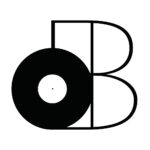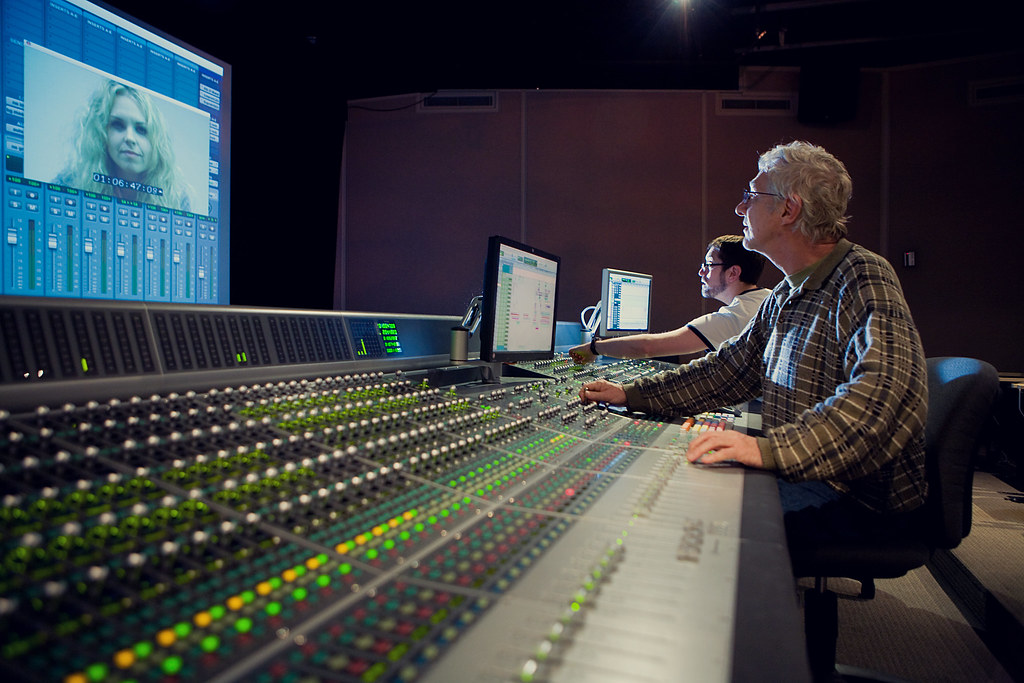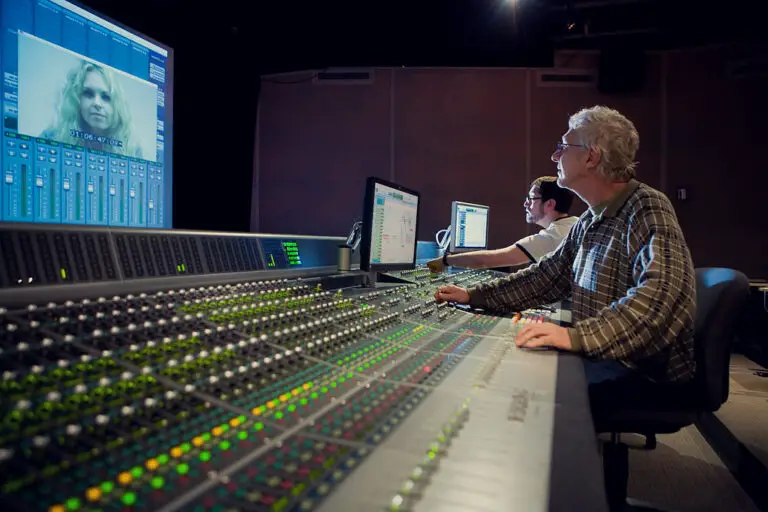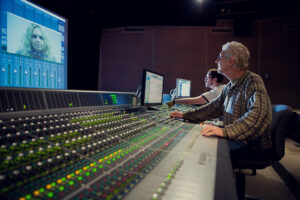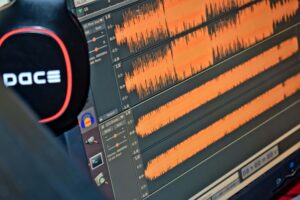Dreaming of a career in sound design, but worried about the cost of a college degree?
Here’s the good news: a fancy diploma isn’t the only way to establish yourself as a sound designer! This guide will show you exactly how to craft a compelling portfolio and gain valuable experience without going into student debt. So, are you ready to learn how to become a sound designer?
To become a sound designer, you don’t need a college/university degree. However, you ABSOLUTELY need a portfolio and experience to land a job and/or contracts as a sound designer. Luckily, you can create a compelling portfolio AND get experience by working on short films, indie games and any other project you can get your hands on. Instead of dishing out THOUSANDS of dollars on tuition fees, your cost-to-entry will be working on projects for free (or for cheap) until you have what it takes to knock on those doors that might have otherwise shut you out! So, let’s get to work and get your sound design career off the ground.
Table of Contents
Developing Your Sound Design Skills
When I first got started as a sound designer, the most exciting part for me was learning the software and plugins!
Here are the DAWs I recommend learning…
- Pro Tools (for TV, film and ads)
- REAPER (for video games)
- Wwise (for video games)
Of course, there are plenty more tools you can learn (FMOD, Unreal Engine 5, etc…), but those are the most important.
I actually have a beginner course for Pro Tools and plenty of FREE tutorials on YouTube.
Regardless of the path you choose, you can learn everything you need with a mix on online courses and YouTube videos.
Now, you’ll also need to familiarize yourself with the plugins (or collections thereof) used by industry professionals…
- SoundQ (FREE sound effects browser)
- Soundminer (PAID sound effects browser)
- Krotos Sound Design Bundle
- Edward Ultimate Collection
Once again, this is just a glimpse of the plugins you’ll be working with throughout your sound design career.
If you want more recommendations, I created a list of essential audio post-production plugins and sound effects libraries that you can download for free by following the links.
I also create lots of tutorials showing you how to use these tools on our YouTube channel, so make sure to SUBSCRIBE!
Once you’ve got your tools, we’re ready to start crafting a sound design portfolio.
Creating Your Sound Design Portfolio
One of the most difficult parts of becoming a sound designer is creating the “perfect” portfolio.
I’m still working on my portfolio to this day, so don’t think it’ll ever stop getting better.
If you’re completely new, you might not even have a project under your belt. BUT, don’t let that stop you!
You can get creative and find free stock footage on sites like Pixabay and Videvo. That’s what I did at the beginning, check it out…
If you’re just getting started, your #1 priority should be PRACTICE!
You can even download scenes from movies and/or video games, mute the audio and do what we refer to as a “sound re-design”.
Sound re-designs are cool because this where you’ll start developing your own personal SFX library.
I do encourage you to develop the ability to record your own SFX and do foley (especially if you’re aiming for video game sound design). However, feel free to experiment with SFX libraries you find on the internet.
Once you’ve got a few projects under your belt (which we’ll talk about later), you may want to create what we refer to as a “demo reel”.
However, you may not be able to share this reel publicly unless you get permission from all parties involved (if you want to see/hear my demo reel, send me an email).
Regardless, you’ll want to start showcasing your sound design “exercises” on social media (Instagram, TikTok and LinkedIn work best) and perhaps even creating a website to make it look even more professional.
Don’t be shy, putting yourself out there is ESSENTIAL if you want to become a sound designer.
Gaining Experience as a Sound Designer
Ah, getting your first gig as a sound designer… I remember mine!
It was a short film that I also did location sound on. I actually didn’t know how to use Pro Tools before taking on this project, so don’t panic if you’re not a Pro Tools expert just yet (I surely wasn’t).
What matters is that you’re making connections in the real world and offering to do what you do; sound design.
Earlier, I mentioned that offering to do this for free (or for cheap) would be your best bet.
You can go ahead and find groups on Facebook or check out film festivals and other industry-specific networking events in your area to get your feet wet. However, I promise you that this will be the most difficult part of becoming a sound designer.
That’s why I emphasized putting yourself (and your work) out there as soon as possible in the previous section.
You can find filmmakers and game developers to collaborate with through social media.
Leveling Up Your Sound Design Career
Leveling up your sound design career happens when you level up your sound design…
The best way to do that? Get some constructive criticism ASAP!
You can join online communities like the Decibel Peak Community to get feedback on your sound design exercises. You’ll also start developing a network of like-minded sound designers which will push you to new heights.
The sooner you do that, the sooner your social media posts will start attracting attention.
Once you start regularly posting high-quality demonstrations of your sound design abilities, it’ll make it that much easier to reach out to creatives that could benefit from your services.
The more of a following you attract, the better the opportunities you’ll be able to create.
It’ll most likely also lead to finding freelance work as a sound designer (which is where you’re more likely to start off).
Finding Work as a Sound Designer
By this point, you’ve already worked on a few passion projects.
And who knows, one of the passion projects you worked on could end up on Tubi like THIS SERIES I worked on!
To get big contracts on feature films and AAA games, you’ll definitely need lots of those.
You’ll also definitely want to create an IMDB page like THIS ONE to show off your credentials (it’s more for TV, film and ads though).
If you want to specialize in video games, you’ll need to have worked on some popular titles. It’s much more competitive of an industry to break into (especially as a freelancer), but you’ll get there eventually if you persevere.
Regardless of the path you choose, the best way to find work as a sound designer is on Facebook Groups.
Here are a few groups I recommend checking out…
- Sound Design | Audio Jobs | Freelancers | Producers| Gigs | Orders | Edit
- Audio Jobs
- Audio/Video Job Exchange
I find lots of work on Facebook Groups, but I also find lots of work through word-of-mouth.
I also have a lot of prospects reaching out to me either through Instagram or through my website.
If you’re more of a team player, you can also consider getting an apprenticeship at a small audio production company. Although, it’s very difficult to get your foot in the door considering how small the sound design teams usually are.
So, let’s just say there are many ways of getting to the same result!
Summary: How To Become a Sound Designer
Alright, you now know the steps to becoming a sound designer for TV, film, ads and even video games.
The #1 piece of advice I can give you is this… Start off your sound design career as a side-hustle (because it can become quite a lucrative side-hustle). If ever you want to take it full-time, you will get there eventually.
Personally, I like the flexibility of doing sound design, location sound and running my other projects.
That’s something you’ll want to consider too; whether you’ll be a freelance sound designer or employed by a studio.
Considering the MASS LAYOFFS in the video game industry though, I would get comfortable being uncomfortable as a freelance sound designer and take it from there. I think it’s a better longterm strategy anyway (you’ll probably also get paid more).
So, to summarize…
- Develop your sound design skills (Pro Tools, REAPER, Wwise, plugins, etc…)
- Create a sound design portfolio (sound re-designs, demo reels, exercises, etc…)
- Volunteer to work on projects (short films, indie games, etc…)
- Post your work on social media and network
- Join groups on Facebook to find work and get feedback
If you do all of this (in order), I promise that you’ll have opportunities rise up within the next year.
Remember, luck is when preparedness meets opportunity!
That being said, the best way to prepare yourself is to join the Decibel Peak Community and connect with like-minded sound designers all over the globe. It’s 100% free and always will be, so what are you waiting for?
Thanks for reading! Here are some other posts you might be interested in…
